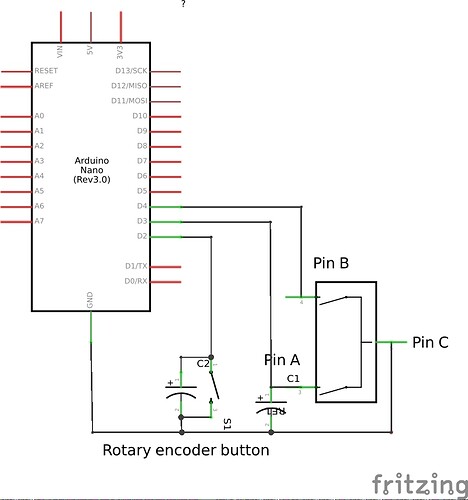Hello. I need to use a rotary encoder in a project that involves menus displayed in a I2C LCD.
I bought one and tried to make it work with some codes from internet. None of them worked for me so I tried to guess it by using the code below.
My encoder has a button and 5 pins. I don't have the model number so I couldn't find the datasheet. It does not come in a module.
In the code below I attached interrupts to pins 2 and 3, and i connected them to the pins A and B of the rotary encoder.
I connected the pin C to ground.
#include <Arduino.h>
struct state {
int a, b;
};
void isr();
void setup() {
pinMode(2, INPUT_PULLUP);
pinMode(3, INPUT_PULLUP);
Serial.begin(115200);
attachInterrupt(0, isr, CHANGE);
attachInterrupt(1, isr, CHANGE);
}
void isr() {
state buff = {digitalRead(2), digitalRead(3)};
Serial.print(buff.a ? 'H' : 'L');
Serial.println(buff.b ? 'H' : 'L');
}
void loop() {
}
And the output was like this:
When I turned the encoder clockwise once:
LH
LH
HH
HH
When I turned the encoder counterclockwise:
LL
LL
HH
HH
So I decided to use only an interrupt in A and detect the next state after a HH. If it was LH, the encoder was turning clockwise; if it was LL, it was turning counterclockwise. I implemented that in this code.
#include <Arduino.h>
struct state {
int a, b;
};
void isr();
void button();
state prev = {1, 1};
int counter = 0, butcounter = 0;
bool change = true, but = false;
unsigned long t = 0;
void setup() {
pinMode(2, INPUT_PULLUP);
pinMode(3, INPUT_PULLUP);
pinMode(4, INPUT_PULLUP);
Serial.begin(115200);
attachInterrupt(1, isr, CHANGE);
}
void isr() {
state buff = {digitalRead(3), digitalRead(4)};
if (!(buff.a && buff.b)) {
if (prev.a && prev.b) {
if (!buff.a && buff.b) {
counter++;
change = true;
} else if (!buff.a && !buff.b) {
counter--;
change = true;
}
}
prev = buff;
} else {
prev = {1, 1};
t = millis();
}
}
void button() {
if (millis() > t+500) {
but = true;
}
}
void loop() {
if (change) {
change = false;
Serial.println(counter);
} else if (but) {
but = false;
Serial.println();
Serial.print(++butcounter);
Serial.println(". Button!");
Serial.println();
}
}
And connected the arduino nano as it is shown in the image attached.
The encoder worked fine, the counter increased when I turned it CW and decreased when it went CCW. The button also worked. Then I used it in my project and connected it the same way. It worked for a while and then stopped. When I used the code above to test it once more, it didn't work properly. I connected the pin A to pin 2 and pin B to 3 and attached at both interrupts in CHANGE mode. To my surprise the B pin was changing all the time and most of the time it was low. A day later the encoder worked for a while and then happened the same. My question is: Am I using the rotary encoder correctly? If I'm not, how is it supposed to be used?
Is the encoder broken?
I'm sorry if I've written too much but I wanted to detail it as much as possible. Thank you!

